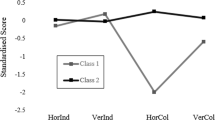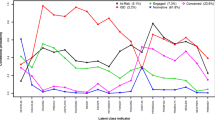Abstract
Gamers represent themselves in online gaming worlds through their avatars. The term “Proteus Effect” (PE) defines the potential influences of the gamers’ avatars on their demeanour, perception and conduct and has been linked with excessive gaming. There is a significant lack of knowledge regarding likely distinct PE profiles and whether these could be differentially implicated with disordered gaming. A normative group of 1022 World of Warcraft (WoW) gamers were assessed in the present study (Mean age = 28.60 years). The Proteus Effect Scale (PES) was used to evaluate the possible avatar effect on gamers’ conduct, and the Internet Gaming Disorder Scale–Short-Form was used to examine gaming disorder behaviors. Latent class profiling resulted in three distinct PE classes, ‘non-influenced-gamers’ (NIGs), ‘perception-cognition-influenced-gamers’ (PCIGs), and ‘emotion-behaviour-influenced-gamers’ (EBIGs). The NIGs reported low rates across all PES items. The PCIGs indicated higher avatar influence in their perception-experience but did not report being affected emotionally. The EBIGs indicated significantly higher avatar influence in their emotion and behaviour than the other two classes but reported stability in their perception of aspects independent of their avatar. Gaming disorder behaviours were reduced for the NIGs and progressively increased for the PCIGs and the EBIGs.

Similar content being viewed by others
Notes
Cluster analysis was not preferred as despite providing information about different clusters of gamers, it does not provide information about the overall fit/applicability of the model and the exact chances of a specific gamer being classified into a certain category. Factor analysis was also not utilised as it refers to the extraction of dimensional-continuous latent factors and not categories-profiles, which was the aim here.
This test assesses the model with the number of typologies proposed against a model with one less typology (class). An insignificant Vuong-Lo-Mendell-Rubin test indicates that the assumed number of classes/typologies/profiles is necessary [41].
The AIC is regarded as an information theory goodness of fit measure—applicable when maximum likelihood estimation is used [42]. This index is used to compare different models. Like the chi square index, the AIC also reflects the extent to which the observed and predicted covariance matrices differ from each other. Models that generate the lowest values are optimal.
The BIC is similar to the AIC expressing the log of a Bayes factor of the target model compared to the saturated model and penalises against complex models. Furthermore, a penalty against small samples is included in BIC calculation [42].
Entropy with values approaching 1 indicate clear delineation of classes [43].
References
Anderson EL, Steen E, Stavropoulos V. Internet use and problematic internet use: a systematic review of longitudinal research trends in adolescence and emergent adulthood. Int J Adolesc Youth. 2017;22(4):430–54. https://doi.org/10.1080/02673843.2016.1227716.
Scerri M, Anderson A, Stavropoulos V, Hu E. Need fulfilment and internet gaming disorder: a preliminary integrative model. Addict Behav Rep. 2019;9:100144. https://doi.org/10.1016/j.abrep.2018.100144.
American Psychiatric Association. Diagnostic and statistical manual of mental disorders (fifth edition). Arlington, VA: American Psychiatric Publishing. 2013. https://doi.org/10.1176/appi.books.9780890425596.744053.
World Health Organization (2019). International Classification of Diseases 11thEdition: Retrieved on the July 10, 2019, from: https://icd.who.int/browse11/l-m/en.
Griffiths MD, Van Rooij AJ, Kardefelt-Winther D, Starcevic V, Király O, Pallesen S, et al. Working towards an international consensus on criteria for assessing Internet gaming disorder: A critical commentary on Petry et al. (2014). Addiction. 2016a;111(1):167–75. https://doi.org/10.1111/add.13057.
Griffiths MD, Kuss DJ, Lopez-Fernandez O, Pontes HM. Problematic gaming exists and is an example of disordered gaming: commentary on: scholars’ open debate paper on the World Health Organization ICD-11 gaming disorder proposal (Aarseth et al.). J Behav Addict. 2017;6(3):296–301. https://doi.org/10.1556/2006.6.2017.037.
Jeong H, Yim HW, Lee SY, Lee HK, Potenza MN, Kwon JH, et al. Discordance between self-report and clinical diagnosis of internet gaming disorder in adolescents. Sci Rep. 2018;8(1):10084. https://doi.org/10.1038/s41598-018-28478-8.
Jo YS, Bhang SY, Choi JS, Lee HK, Lee SY, Kweon YS. Clinical characteristics of diagnosis for internet gaming disorder: comparison of DSM-5 IGD and ICD-11 GD diagnosis. J Clin Med. 2019;8(7):945. https://doi.org/10.3390/jcm8070945.
Van Rooij AJ, Ferguson CJ, Colder Carras M, Kardefelt-Winther D, Shi J, Aarseth E, et al. A weak scientific basis for gaming disorder: let us err on the side of caution. J Behav Addict. 2018;7(1):1–9. https://doi.org/10.1556/2006.7.2018.19.
Brand M, Wegmann E, Stark R, Müller A, Wölfling K, Robbins TW, et al. The interaction of person-affect-cognition-execution (I-PACE) model for addictive behaviors: update, generalization to addictive behaviors beyond internet-use disorders, and specification of the process character of addictive behaviors. Neurosci Biobehav Rev. 2019;104:1–10. https://doi.org/10.1016/j.neubiorev.2019.06.032.
Griffiths MD, Nuyens F. An overview of structural characteristics in problematic videogame playing. Curr Addict Rep. 2017;4:272–83. https://doi.org/10.1007/s40429-017-0162-y.
Liew LWL, Stavropoulos V, Adams BLM, Burleigh TL, Griffiths MD. Internet gaming disorder: the interplay between physical activity and user–avatar relationship. Behaviour and Information Technology. 2018;37:558–74. https://doi.org/10.1080/0144929X.2018.1464599.
Stavropoulos, V., Burleigh, T. L., Beard, C. L., Gomez, R., & Griffiths, M. D. (2018). Being there: a preliminary study examining the role of presence in internet gaming disorder. International Journal of Mental Health and Addiction, 1-11. Epub ahead of print. doi: https://doi.org/10.1007/s11469-018-9891-y.
Burleigh TL, Stavropoulos V, Liew LWL, Adams BLM, Griffiths MD. Depression, internet gaming disorder, and the moderating effect of the gamer-avatar relationship: an exploratory longitudinal study. Int J Ment Heal Addict. 2018;16:102–24. https://doi.org/10.1007/s11469-017-9806-3.
Blinka, L. (2008). The relationship of players to their avatars in MMORPGs: differences between adolescents, emerging adults and adults. Cyberpsychology: Journal of Psychosocial Research on Cyberspace, 2(1), 5. Retrieved July 10, 2019, from: https://cyberpsychology.eu/article/view/4211/3252
Jones C, Scholes L, Johnson D, Katsikitis M, Carras MC. Gaming well: links between videogames and flourishing mental health. Front Psychol. 2014;5:260. https://doi.org/10.3389/fpsyg.2014.00260.
Ratan RA, Dawson M. When Mii Is Me. Commun Res. 2015;43(8):1065–93. https://doi.org/10.1177/0093650215570652.
Dindar M, Ortiz de Gortari AB. Turkish validation of the game transfer phenomena scale (GTPS): measuring altered perceptions, automatic mental processes and actions and behaviours associated with playing video games. Telematics Inform. 2017;34:1802–13. https://doi.org/10.1016/j.tele.2017.09.003.
Ortiz de Gortari AB, Pontes HM, Griffiths MD. The game transfer phenomena scale: an instrument for investigating the nonvolitional effects of video game playing. Cyberpsychology, Behavior & Social Networking. 2015;18(10):588–94. https://doi.org/10.1089/cyber.2015.0221.
Ortiz de Gortari AB, Oldfield B, Griffiths MD. An empirical examination of factors associated with game transfer phenomena severity. Comput Hum Behav. 2016;64:274–84. https://doi.org/10.1016/j.chb.2016.06.060.
Yee N, Bailenson JN, Ducheneaut N. The Proteus effect. Commun Res. 2009;36(2):285–312. https://doi.org/10.1177/0093650208330254.
Encyclopaedia Britannica (2019). Proteus, Greek mythology. Retrieved July 10, 2019, from: https://www.britannica.com/topic/Proteus-Greek-mythology
Stavropoulos, V., Cokorilo, S., Kambouropoulos, A., Collard, J. & Gomez, R. (2019a). Cognitive behavioural therapy online for adult depression: a 10 year systematic literature review. Curr Psychiatr Rev,in press.
Stavropoulos, V., Bamford, L., Beard, C., Gomez, R., & Griffiths, M. D. (2019b). Test-retest measurement invariance of the nine-item internet gaming disorder scale in two countries: a preliminary longitudinal study. International Journal of Mental Health and Addiction, 1-18. Epub ahead of print. https://doi.org/10.1007/s11469-019-00099-w.
Riva, G., Davide, F., & IJsselsteijn, W. A. (Eds.). (2003). Studies in new technologies and practices in communication. Being there: concepts, effects and measurements of user presence in synthetic environments. Amsterdam, Netherlands: IOS Press.
Morcos, M., Stavropoulos, V., Rennie, J. J., Clark, M., & Pontes, H. M. (2019). Internet gaming disorder: compensating as a Draenei in world of Warcraft. International Journal of Mental Health and Addiction, 1-17. Epub ahead of print. doi: https://doi.org/10.1007/s11469-019-00098-x.
Billieux J, Van der Linden M, Achab S, Khazaal Y, Paraskevopoulos L, Zullino D, et al. Why do you play world of Warcraft? An in-depth exploration of self-reported motivations to play online and in-game behaviours in the virtual world of Azeroth. Comput Hum Behav. 2013;29(1):103–9. https://doi.org/10.1016/j.chb.2012.07.021.
Ghuman D, Griffiths MD. A cross-genre study of online gaming: player demographics, motivation for play, and social interactions among players. International Journal of Cyber Behavior, Psychology and Learning. 2012;2(1):13–29. https://doi.org/10.4018/ijcbpl.2012010102.
Griffiths MD, & Pontes HM. The future of gaming disorder research and player protection: what role should the video gaming industry and researchers play?. Int J Ment Health Ad. 2019;1–7. https://doi.org/10.1007/s11469-019-00110-4.
Griffiths M, King D, Demetrovics Z. DSM-5 internet gaming disorder needs a unified approach to assessment. Neuropsychiatry. 2014;4(1):1–4. https://doi.org/10.2217/NPY.13.82.
Hamari, J., & Tuunanen, J. (2014). Player types: A meta-synthesis. Retrieved July 10, 2019, from: https://trepo.tuni.fi/bitstream/handle/10024/99064/player_types_a_meta_synthesis.pdf?sequence=1
Nagygyörgy K, Urbán R, Farkas J, Griffiths MD, Zilahy, ...Demetrovics, Z. Typology and socio-demographic characteristics of massively multiplayer online game players. International Journal of Human-Computer Interaction. 2013;29:192–200. https://doi.org/10.1080/10447318.2012.702636.
Torres-Rodríguez A, Griffiths MD, Carbonell X, Farriols-Hernando N, Torres-Jimenez E. Internet gaming disorder treatment: a case study evaluation of four different types of adolescent problematic gamers. Int J Ment Heal Addict. 2019;17(1):1–12. https://doi.org/10.1007/s11469-017-9845-9.
Pontes HM, Griffiths MD. Measuring DSM-5 internet gaming disorder: development and validation of a short psychometric scale. Comput Hum Behav. 2015;45:137–43. https://doi.org/10.1016/j.chb.2014.12.006.
Van Looy J, Courtois C, De Vocht M, De Marez L. Player identification in online games: validation of a scale for measuring identification in MMOGs. Media Psychol. 2012;15(2):197–221. https://doi.org/10.1080/15213269.2012.674917.
Griffiths MD. The use of online methodologies in data collection for gambling and gaming addictions. Int J Ment Heal Addict. 2010a;8(1):8–20. https://doi.org/10.1007/s11469-009-9209-1.
Weigold A, Weigold IK, Russell EJ. Examination of the equivalence of self-report survey-based paper-and-pencil and internet data collection methods. Psychol Methods. 2013;18(1):53–70. https://doi.org/10.1037/a0031607.
Muthén, L. K., & Muthén, B. (2019). Mplus. The comprehensive modelling program for applied researchers: User’s guide, 5. Los Angeles, CA: Muthén & Muthén.
Carras MC, Kardefelt-Winther D. When addiction symptoms and life problems diverge: a latent class analysis of problematic gaming in a representative multinational sample of European adolescents. Eur Child Adolesc Psychiatry. 2018;27(4):513–25. https://doi.org/10.1007/s00787-018-1108-1.
Li CH. Confirmatory factor analysis with ordinal data: comparing robust maximum likelihood and diagonally weighted least squares. Behav Res Methods. 2016;48(3):936–49. https://doi.org/10.3758/s13428-015-0619-7.
Jung T, Wickrama KAS. An introduction to latent class growth analysis and growth mixture modeling. Soc Personal Psychol Compass. 2008;2(1):302–17. https://doi.org/10.1111/j.1751-9004.2007.00054.x.
Vrieze SI. Model selection and psychological theory: a discussion of the differences between the Akaike information criterion (AIC) and the Bayesian information criterion (BIC). Psychol Methods. 2012;17(2):228–43. https://doi.org/10.1037/a0027127.
Celeux G, Soromenho G. An entropy criterion for assessing the number of clusters in a mixture model. J Classif. 1996;13(2):195–212. https://doi.org/10.1007/BF01246098.
Larose C, Harel O, Kordas K, Dey DK. Latent class analysis of incomplete data via an entropy-based criterion. Statistical Methodology. 2016;32:107–21. https://doi.org/10.1016/j.stamet.2016.04.004.
Griffiths MD. The role of context in online gaming excess and addiction: some case study evidence. Int J Ment Heal Addict. 2010b;8:119–25. https://doi.org/10.1007/s11469-009-9229-x.
Tisseron S. L'ado et ses avatars. Adolescence. 2009;3:591–600.
Author information
Authors and Affiliations
Contributions
VS: contributed to the literature review, hypotheses formulation, data collection and analyses, and the structure and sequence of theoretical arguments.
Contact: vasilisstavropoylos80@gmail.com
HP: contributed to the theoretical consolidation of the current work and revised and edited the final manuscript.
Contact: contactme@halleypontes.com
RG contributed to the literature review, hypotheses formulation, data collection and analyses, and the structure and sequence of theoretical arguments.
Contact: rapson.gomez@federation.edu.au
BS contributed to the theoretical consolidation of the current work and revised and edited the final manuscript.
Contact: bruno.schivinski@gmail.com
MG contributed to the theoretical consolidation of the current work and revised and edited the final manuscript.
Contact: mark.griffiths@ntu.ac.uk
Corresponding author
Ethics declarations
Conflict of Interest
The authors of the present study do not report any conflict of interest.
Ethical Standards – Animal Rights
All procedures performed in the study involving human participants were in accordance with the ethical standards of the institutional and/or national research committee and with the 1964 Helsinki declaration and its later amendments or comparable ethical standards. This article does not contain any studies with animals performed by any of the authors.
Informed Consent
Informed consent was obtained from all individual participants included in the study.
Confirmation Statement
Authors confirm that this paper has not been either previously published or submitted simultaneously for publication elsewhere.
Copyright
Authors assign copyright or license the publication rights in the present article.
Additional information
Publisher’s Note
Springer Nature remains neutral with regard to jurisdictional claims in published maps and institutional affiliations.
Rights and permissions
About this article
Cite this article
Stavropoulos, V., Pontes, H.M., Gomez, R. et al. Proteus Effect Profiles: how Do they Relate with Disordered Gaming Behaviours?. Psychiatr Q 91, 615–628 (2020). https://doi.org/10.1007/s11126-020-09727-4
Published:
Issue Date:
DOI: https://doi.org/10.1007/s11126-020-09727-4




